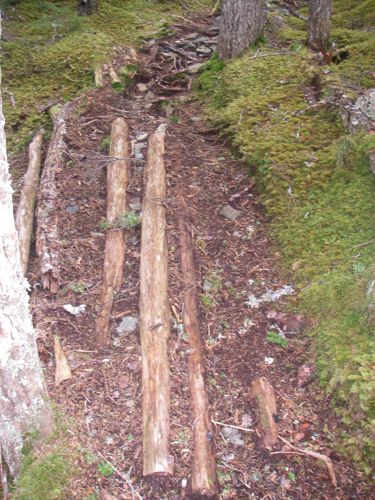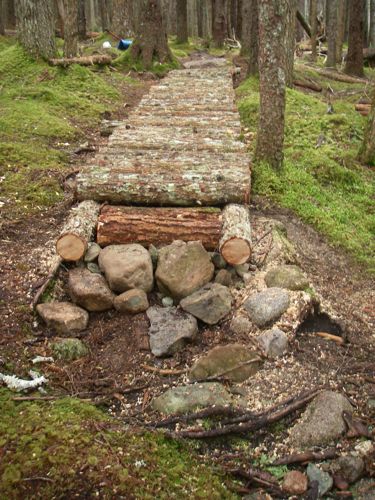Saturday we worked with our nearest neighbors to improve the main trail over the ridge.
For reasons none of us understand, the people who built our “homestead,” the original settlers on this side of Mud Bay, lined sections of the trail with thin logs. In this region, log sections laid on the trail to improve footing or elevate above mud are called “corduroy.” Generally, people lay short sections of log perpendicular to the trail for this; the parallel long lengths puzzle us. After years of use, they’re rotting away in most spots. Where they aren’t, they make the trail hazardous—walking on the barkless wood when it’s wet and slick can cause falls. We decided to rip the old logs out. We would put in crosswise corduroy where we could. We would also fill low spots in the trail with cobbles and gravel ‘mined” from the thin soil beneath the root wads of fallen trees.
We worked for a few hours in a cloud of mosquitoes but otherwise pleasant weather. When we finished, we had a new 25 foot section of trail spanned by a corduroy “bridge” through one of the worst spots on the trail. It’s a lot like the section of trail we improved as a family for Michelle’s birthday a few years ago (see Trail Improvements) but, since our neighbors have a chain saw, it went a lot faster!
We plan to get together about once a week for a few hours of work. We have a few more places we’d like to corduroy, and some other places that need some sort of work, although we’re not exactly sure yet how we’ll deal with the problems there. Eventually, the trail will be much safer for traveling. After one session, it’s already vastly improved.
We worked in confidence, knowing that as soon as we returned home, we could eat lunch. Michelle had set a pot of leftover soup to warm in the Solar Oven before we left so we worked hard, knowing that food waited for us at home, rather than planning ahead so we could get home and make lunch in a timely manner. This, I believe, will be the greatest benefit of the new Solar Oven (see Cooking With Solar).
As we ate lunch on the veranda, the herring run, which had started trickling in that morning, intensified. Soon, a humpback whale cruised by within a yard or two of our beach cliff, scooping up fish as it swam. We spent several hours sitting on the rocks, watching the whale and the fish, knowing that we’d already put in a good day’s work.
As a bonus, we did return to work later in the afternoon, and after dinner that evening. Michelle worked in the garden, and I dismantled the old solar array, interrupted often by the whale’s continuing activity. In the late evening, it swam to the middle of the fjord and began tail lobbing, raising its tail high above the water’s surface and smashing it down hard. It sounded like cannon fire echoing off the mountains around us. It flailed away continually for 10 to 15 minutes.
Not a bad day on the “homestead”. Not bad at all!



